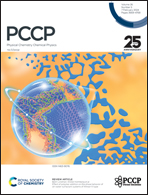Anisotropic fluid flows in black phosphorus nanochannels†
Abstract
With the development of advanced micro/nanoscale technologies, two-dimensional materials have emerged from laboratories and have been applied in practice. To investigate the mechanisms of solid–liquid interactions in potential applications, molecular dynamics simulations are employed to study the flow behavior of n-dodecane (C12) molecules confined in black phosphorus (BP) nanochannels. Under the same external conditions, a significant difference in the velocity profiles of fluid molecules is observed when flowing along the armchair and zigzag directions of the BP walls. The average velocity of C12 molecules flowing along the zigzag direction is 9-fold higher than that along the armchair direction. The friction factor at the interface between C12 molecules and BP nanochannels and the orientations of C12 molecules near the BP walls are analyzed to explain the differences in velocity profiles under various flow directions, external driving forces, and nanochannel widths. The result shows that most C12 molecules are oriented parallel to the flow direction along the zigzag direction, leading to a relatively smaller friction factor hence a higher average velocity. In contrast, along the armchair direction, most C12 molecules are oriented perpendicular to the flow direction, leading to a relatively larger friction factor and thus a lower average velocity. This work provides important insights into understanding the anisotropic liquid flows in nanochannels.

- This article is part of the themed collection: 2024 PCCP HOT Articles


 Please wait while we load your content...
Please wait while we load your content...